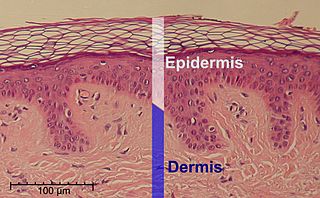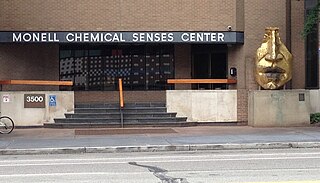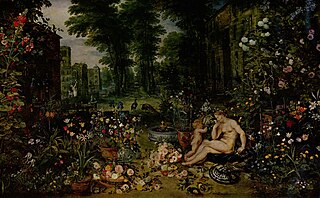Related Research Articles

Skin is the layer of usually soft, flexible outer tissue covering the body of a vertebrate animal, with three main functions: protection, regulation, and sensation.

The epidermis is the outermost of the three layers that comprise the skin, the inner layers being the dermis and hypodermis. The epidermis layer provides a barrier to infection from environmental pathogens and regulates the amount of water released from the body into the atmosphere through transepidermal water loss.

A sebaceous gland or oil gland is a microscopic exocrine gland in the skin that opens into a hair follicle to secrete an oily or waxy matter, called sebum, which lubricates the hair and skin of mammals. In humans, sebaceous glands occur in the greatest number on the face and scalp, but also on all parts of the skin except the palms of the hands and soles of the feet. In the eyelids, meibomian glands, also called tarsal glands, are a type of sebaceous gland that secrete a special type of sebum into tears. Surrounding the female nipple, areolar glands are specialized sebaceous glands for lubricating the nipple. Fordyce spots are benign, visible, sebaceous glands found usually on the lips, gums and inner cheeks, and genitals.

The olfactory system or sense of smell is the sensory system used for smelling (olfaction). Olfaction is one of the special senses, that have directly associated specific organs. Most mammals and reptiles have a main olfactory system and an accessory olfactory system. The main olfactory system detects airborne substances, while the accessory system senses fluid-phase stimuli.
Body odor or body odour (BO) is present in all animals and its intensity can be influenced by many factors. Body odor has a strong genetic basis, but can also be strongly influenced by various factors, such as sex, diet, health, and medication. The body odor of human males plays an important role in human sexual attraction, as a powerful indicator of MHC/HLA heterozygosity. Significant evidence suggests that women are attracted to men whose body odor is different from theirs, indicating that they have immune genes that are different from their own, which may produce healthier offspring.
Lipid peroxidation, or lipid oxidation, is a complex chemical process that leads to oxidative degradation of lipids, resulting in the formation of peroxide and hydroperoxide derivatives. It occurs when free radicals, specifically reactive oxygen species (ROS), interact with lipids within cell membranes, typically polyunsaturated fatty acids (PUFAs) as they have carbon–carbon double bonds. This reaction leads to the formation of lipid radicals, collectively referred to as lipid peroxides or lipid oxidation products (LOPs), which in turn react with other oxidizing agents, leading to a chain reaction that results in oxidative stress and cell damage.

Oct-1-en-3-one (CH2=CHC(=O)(CH2)4CH3), also known as 1-octen-3-one or amyl vinyl ketone, is the odorant that is responsible for the typical "metallic" smell of metals and blood coming into contact with skin. Oct-1-en-3-one has a strong metallic mushroom-like odor with an odor detection threshold of 0.03–1.12 µg/m3 and it is the main compound responsible for the "smell of metal", followed by decanal (smell: orange skin, flowery) and nonanal (smell: tallowy, fruity). Oct-1-en-3-one is the degradative reduction product of the chemical reaction of skin lipid peroxides and Fe2+. Skin lipid peroxides are formed from skin lipid by oxidation, either enzymatically by lipoxygenases or by air oxygen. Oct-1-en-3-one is a ketone analog of the alkene 1-octene.
Vaccenic acid is a naturally occurring trans fatty acid and an omega-7 fatty acid. It is the predominant kind of trans-fatty acid found in human milk, in the fat of ruminants, and in dairy products such as milk, butter, and yogurt. Trans fat in human milk may depend on trans fat content in food.

The Monell Chemical Senses Center is a non-profit independent scientific institute located at the University City Science Center campus in Philadelphia, Pennsylvania. Monell conducts and publishes interdisciplinary basic research on taste, smell, and chemesthesis.

The human skin is the outer covering of the body and is the largest organ of the integumentary system. The skin has up to seven layers of ectodermal tissue guarding muscles, bones, ligaments and internal organs. Human skin is similar to most of the other mammals' skin, and it is very similar to pig skin. Though nearly all human skin is covered with hair follicles, it can appear hairless. There are two general types of skin, hairy and glabrous skin (hairless). The adjective cutaneous literally means "of the skin".
Danielle Renee Reed is an American geneticist employed at the Monell Chemical Senses Center in Philadelphia, Pennsylvania. She is most notable for her papers regarding genetic variation in taste and obesity in mice and humans.
Corneocytes are terminally differentiated keratinocytes and compose most of the stratum corneum, the outermost layer of the epidermis. They are regularly replaced through desquamation and renewal from lower epidermal layers and are essential for its function as a skin barrier.

2-Nonenal is an unsaturated aldehyde. The colorless liquid is an important aroma component of aged beer and buckwheat and insoluble in water.
George Preti was an analytical organic chemist who worked at the Monell Chemical Senses Center in Philadelphia, Pennsylvania. For more than four decades, his research focused on the nature, origin, and functional significance of human odors. Dr. Preti's laboratory has identified characteristic underarm odorants, and his later studies centered upon a bioassay-guided approach to the identification of human pheromones, odors diagnostic of human disease, human malodor identification and suppression and examining the “odor-print” of humans.
Dr. Johan N. Lundström is a Swedish biologist and psychologist.
Pamela Dalton is a cognitive psychologist. She has a Ph.D. in experimental psychology and a Masters in Public Health. Dalton is frequently quoted by the popular press as an authority on environmental odors. She has done extensive research in the fields of sick building syndrome and multiple chemical sensitivity. In the past she has worked with the United States Department of Defense on nonlethal weapons development, or the enhancement of bad odors as weapons. She currently works at the Monell Chemical Senses Center.

An odor or odour is caused by one or more volatilized chemical compounds that are generally found in low concentrations that humans and many animals can perceive via their sense of smell. An odor is also called a "smell" or a "scent", which can refer to either an unpleasant or a pleasant odor.

The sense of smell, or olfaction, is the special sense through which smells are perceived. The sense of smell has many functions, including detecting desirable foods, hazards, and pheromones, and plays a role in taste.
Foot odor or bromodosis is a type of body odor that affects the feet of humans.

Olfactic communication is a channel of nonverbal communication referring to the various ways people and animals communicate and engage in social interaction through their sense of smell. Our human olfactory sense is one of the most phylogenetically primitive and emotionally intimate of the five senses; the sensation of smell is thought to be the most matured and developed human sense.
References
- ↑ Sifferlin, Alexandra (31 May 2012). "'Old-Person Smell' Really Exists, Scientists Say". Time. Archived from the original on 4 July 2015. Retrieved 10 February 2016.
- ↑ Mitro, Susanna; Gordon, Amy R.; Olsson, Mats J.; Lundström, Johan N. (30 May 2012). "The Smell of Age: Perception and Discrimination of Body Odors of Different Ages". PLOS ONE. 7 (5): e38110. Bibcode:2012PLoSO...738110M. doi: 10.1371/journal.pone.0038110 . PMC 3364187 . PMID 22666457.
- ↑ Haze, S.; Gozu, Y.; Nakamura, S.; Kohno, Y.; Sawano, K.; Ohta, H.; Yamazaki, K. (2001). "2-Nonenal Newly Found in Human Body Odor Tends to Increase with Aging". Journal of Investigative Dermatology . 116 (4): 520–4. doi: 10.1046/j.0022-202x.2001.01287.x . PMID 11286617.
- ↑ Gallagher, M.; Wysocki, C.J.; Leyden, J.J.; Spielman, A.I.; Sun, X.; Preti, G. (October 2008). "Analyses of volatile organic compounds from human skin". British Journal of Dermatology. 159 (4): 780–791. doi:10.1111/j.1365-2133.2008.08748.x. PMC 2574753 . PMID 18637798.
- ↑ MacMillan, Amanda. "Scientists Confirm Existence of 'Old Person Smell'". Health.com. Health Media Ventures, Inc. Archived from the original on 8 September 2015. Retrieved 30 May 2012.
- ↑ Stücker, M.; Struk, A.; Altmeyer, P.; Herde, M.; Baumgärtl, H.; Lübbers, D. W. (2002). "The cutaneous uptake of atmospheric oxygen contributes significantly to the oxygen supply of human dermis and epidermis". The Journal of Physiology. 538 (3): 985–994. doi:10.1113/jphysiol.2001.013067. PMC 2290093 . PMID 11826181.
- ↑ "The special scent of age". EurekAlert! (Press release). Monell Chemical Senses Center. 30 May 2012. Archived from the original on 20 June 2015.
- ↑ Levenstein, Steve (6 August 2008). "Japan's Aging Population Deals with Old Man Smell". Inventor Spot. Halcyon Solutions Inc. Archived from the original on 6 September 2015.